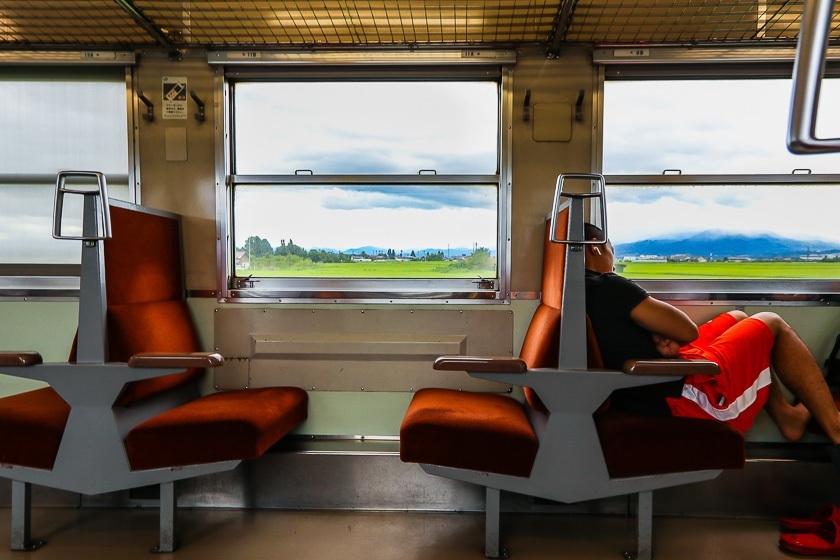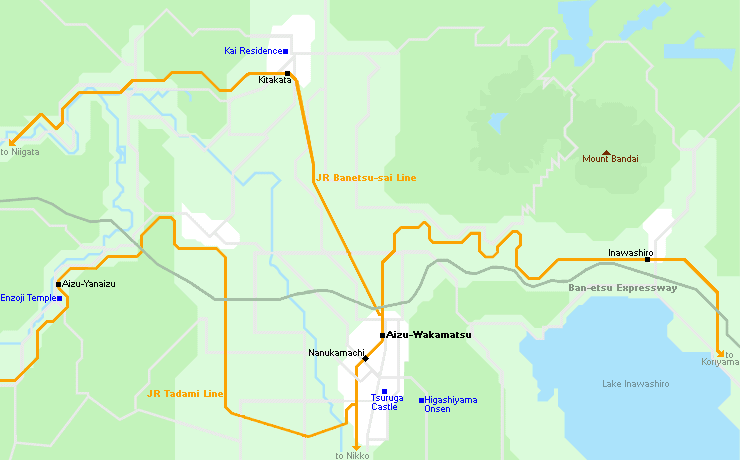Travel in Oku Aizu, Fukushima

Deviating off the popular sightseeing routes, the inaugural Solo Female Travel begins in Fukushima Prefecture. For this overnight trip, I based myself in the town of Aizu-Wakamatsu and stayed overnight at a ryokan in Higashiyama Onsen, a hot spring resort on the outskirts of the town. I went on two side trips to Aizu-Yanaizu and Kitakata, where I made sure to try the local specialties as well as go sightseeing. Our basic guide to traveling alone can be read here.

Day 1
I started my journey and made my way to my first destination, Aizu-Yanaizu (about four hours and around 10,000 yen one way from Tokyo with good connections). The countryside town of Yanaizu is quiet and a great contrast to the bustling metropolis that is Tokyo. I arrived in Aizu-Yanaizu in the afternoon, and after checking the train timetable for the return journey, I realized that I had only two hours to spend in the small town as train service at Aizu Yanaizu is extremely infrequent. It was a relief to find out that there aren't that many attractions in the town, so that I could cover the main spots and still make it back to the station for the return train.



The main sightseeing spots are all within a 20 minute walk from the station, and I found that I had enough time to see almost everything. My first stop in Aizu-Yanaizu was Enzoji Temple, a ten minute walk downhill from the station. Legend has it that the temple was rebuilt with the help of akabeko - red cows - that carried the large and heavy wood that was needed up the hill. As such, Yanaizu is often acknowledged as the birthplace of the akabeko which are widely sold around the region as popular souvenirs, and there are large statues of the cow on the temple grounds.




From Enzoji Temple, I made my way further down along the bridges that cross the Tadami River and towards the Aizu-Yanaizu Roadside Station which took me another 10-15 minutes. I wandered around the area checking out the small museum dedicated to Saito Kiyoshi, a woodblock artist from the Aizu Region before returning to the station.





Local specialties from Aizu-Yanaizu include sauce katsudon (pork cutlet rice bowl) and awamanju (a steamed, glutinous rice dessert with red bean paste inside). It would have been a pity to miss them during my visit, and I'm happy to report that they did not disappoint.





The JR Tadami Line brought me back to Aizu-Wakamatsu where I headed straight to my accommodation at Higashiyama Onsen. The best way to get to Higashiyama Onsen is on the sightseeing loop bus that departs outside of the station and stops at Higashiyama Onsen-iriguchi or Higashiyama Onsen-eki (210 yen per ride). Many of the ryokan can be reached on foot from either stop, and hotel transfers can be arranged from these bus stops when the weather is bad.





Day 2
Checking out after breakfast the next day, I spent the first half of the day in Aizu-Wakamatsu. I took the sightseeing loop bus from Higashiyama Onsen to Tsuruga Castle and paid a visit to the Rinkaku Teahouse Garden as well. The museum inside the castle has displays showing the history of the Aizu Region and the lords who ruled from the castle. It made for an educational trip to get an overview of the land and its history.



The Aizu Region is known for its high-quality sake, and a number of local labels have won both international and domestic competitions. A short walk from the north exit of Tsuruga Castle is the Aizu Miyaizumi Brewery, one of the numerous breweries in the region, which offers free sake tasting at their shop. Lunch was at an old established restaurant, Takino, that specializes in an Aizu delicacy called wappa-meshi which is rice and other local ingredients steamed in a wooden container.




From there, I took the sightseeing loop bus back to Aizu-Wakamatsu Station to catch the train to Kitakata. According to the train schedule, I had about three hours to spend in the city so that I wouldn't have to arrive back home too late. The city is famous for its storehouses and there are some dating back as far as the Edo Period.
I took the Kitakata sightseeing loop bus (200 yen per ride) from the station to the Kai Residence, one of the biggest and most impressive residences and storehouses in the city, which is also designated national cultural property. Alternatively, the residence could be reached in a 20-minute walk from the station. While admission is free, visitors can only view the exterior of the residence, the inner garden as well as some of the opulent rooms through open doors.




After that, I walked down Kitakata's main street which is lined by many old storehouses. These old buildings all have different exteriors which made for an interesting stroll back towards Kitakata Station. Along the way, I stopped by the Yamatogawa Sake Brewery to check out their museum and sake.
The brewery has three storehouses, one from the Edo, Taisho and Showa periods respectively that are filled with sake making equipment from back in the day, as well as their current line of sake varieties. Visitors can join their free, guided museum tours (which was my choice) or go on a self-guided tour before ending up in the shop and tasting area.






Finally, no trip to Kitakata is complete without having Kitakata Ramen. Quite unlike many ramen shops in the rest of Japan, ramen shops here open from the morning, and having a bowl to start the day (or end it if you work the night shift) is a thing here. The noodles in Kitakata Ramen tend to be slightly thicker than average, and the light broth tends to be either salt or soy sauce based. I made my way to a popular ramen shop to have an early dinner before the train ride back to Aizu-Wakamatsu and Tokyo.



With that, my overnight trip came to an end, and I found myself back home. There was so much to see and do, that I sometimes forgot that I was traveling alone. The tourist attractions I visited were easily navigated on foot, and the sightseeing loop buses were simple to work out. One difficulty could be entering restaurants alone, but I found that the staff were friendly and sat me down quickly while fellow diners did not even give me more than a glance. All in all, it was a reasonably straightforward trip for which the main requirement for me was to be mindful of the train schedule. Aside from that, I felt like I had covered a fair bit of ground and given myself a primer to the Aizu Region.
Till the next trip!


Getting there and around
Aizu-Wakamatsu was the base for this itinerary, and the side trips to Aizu-Yanaizu and Kitakata were made out from there. How to get to Aizu-Wakamatsu.
From Aizu-Wakamatsu, the JR Banetsu-sai Line continues on to Kitakata (15 minutes, 320 yen one way, one departure every 1-2 hours), while the JR Tadami Line makes the journey to Aizu-Yanaizu (60 minutes, 670 yen one way, one departure every 1-5 hours). The trains are covered by the Japan Rail Pass.





